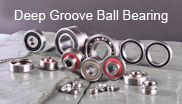Linear ball bearing
1. A linear ball bearing comprising:
an outer sleeve, a ball retainer, and a plurality of ball tracks,
each of said ball tracks comprises a linear loaded ball groove, a linear unloaded ball groove, and two ball turning grooves which connect said linear loaded ball groove and said linear unloaded ball groove to form a continuous circuit,
each of said turning grooves includes a first and a second stage, in said first stage steel balls of said linear ball bearing move from said loaded ball groove through an approximately 120 degree turn, in said first stage a depth of said turning groove is gradually decreased, said depth being decreased in said first stage an amount equal to one-half the difference in elevation of said loaded ball groove and said unloaded ball groove, and in said second stage said depth of said ball groove is further decreased until it coincides with said unloaded ball groove, at which point said steel balls protrude beyond an outer surface of said ball retainer, a small indentation on an inner surface of said outer sleeve accommodating said protrusion of said steel balls.
2. The linear ball bearing as claimed in claim 1, wherein:
snap rings are locked into grooves on each end of said outer sleeve to prevent separation between said ball retainer and said the outer sleeve,
said snap rings include multiple radial openings to allow said snap rings to be easily locked into said grooves.
The purpose of the present invention is to provide a new ball circulation system for a linear ball bearing to simplify the manufacturing process of the ball bearing. The linear ball bearing produces very little friction as it moves along the bearing shaft. The linear ball bearing comprises an outer sleeve, a ball retainer, several ball tracks, and two snap rings. Each ball track comprises a linear loaded ball groove, a linear unloaded ball groove, and two semi-circular ball turning grooves which allow the steel balls to turn through 180 degrees between the two linear ball grooves.
The bottom of the loaded ball groove has an opening to allow one side of the steel balls to contact the shaft while the opposite side of the steel balls contacts the inner surface of the outer sleeve. The rolling movement of the steel balls will only generate a small amount of friction. A circular channel forms the tracks to facilitate the movement of the balls. The tracks for the steel balls comprise two semi-circular turning grooves that are connected to loaded and unloaded ball grooves. The loaded and unloaded ball grooves are positioned on different radial positions on the retainer¡¯s outer surface. Thus the depth of the semi-circular ball turning groove has to change to allow the steel balls to turn from the loaded ball groove to the unloaded ball groove smoothly. Furthermore, the change of depth of the semi-circular ball turning grooves influences the geometric shape of the inner surface of the outer sleeve.
For the purpose of simplifying the geometry of the inner surface of the outer sleeve to improve manufacturablity, and to increase the ball retainer¡¯s strength the present invention designs a new two-stage depth variation for the semi-circular ball turning grooves.
The depth change in the ball turning groove at a first stage allows the steel balls to begin to move from the loaded ball groove to the semi-circular ball turning groove, moving through an arc of approximately 120 degrees. In this stage, the elevation of the floor of the ball turning groove is gradually raised to 1/2H level, and the steel balls are kept inside the groove. The symbol H represents the difference of the height from the loaded groove¡¯s level to the unloaded groove¡¯s level. The opening of the loaded ball groove extends to the ball turning groove. A slanted surface of the outer sleeve is simply cut by a lathe machine. In this region the steel ball leaves the shaft surface and easily turns in or turns out between the loaded groove and the turning groove.
At a second stage of the turning groove, the steel balls continue through the remaining arc of about 60 degrees. In this region, the elevation of the floor of the turning groove is gradually raised to the unloaded groove¡¯s level. Due to the increasing elevation of the groove at this stage, the steel balls will partially protrude beyond the outer surface of the retainer. Thus, there has to be an indentation on the inner surface of the outer sleeve to accommodate the passage of the steel balls.
The variations of depth in the different stages of the turning groove is designed to improve the unloaded ball groove¡¯s strength. Since the unloaded groove¡¯s depth is almost equivalent to the ball¡¯s radius, there has to be a semi-circular shaped indentation on the inner surface of the outer sleeve that corresponds to the unloaded ball groove to allow the steel balls to move within the groove smoothly. The two stages¡¯ depth variation of the semi-circular ball turning groove for the steel ball retainer can maximize the balls¡¯ circulation effect by simplifying the inner geometry of the outer sleeve and reducing the potential for jamming.
The present invention uses several evenly distributed square projections on the outer surface of the retainer and indentations on the inner surface of the outer sleeve to prevent the retainer from rotating inside the outer sleeve. Also, to prevent the retainer from loosening or sliding out, this invention adopts two snap rings placed on the ends of the ball bearing. Each snap ring is made of plastic with evenly distributed radial openings for easy assembling with the sleeve.



